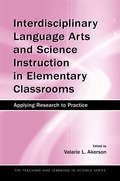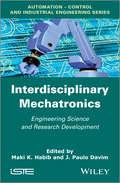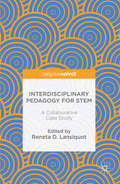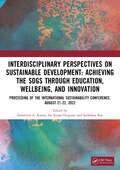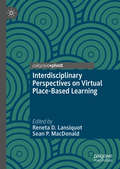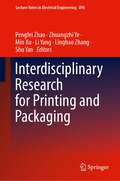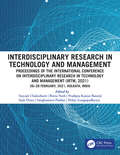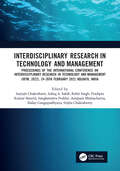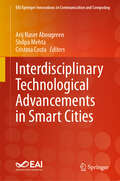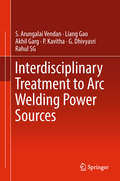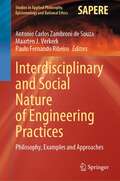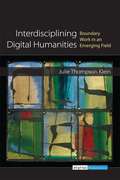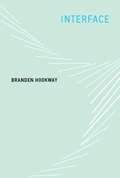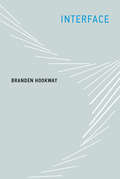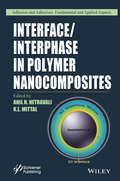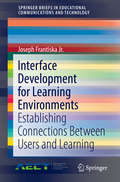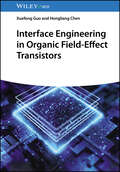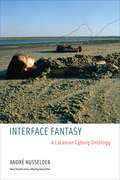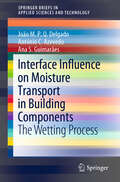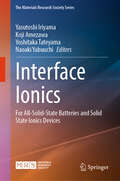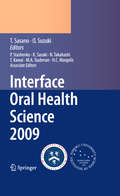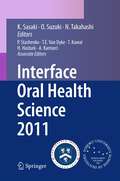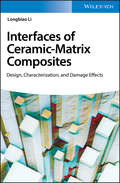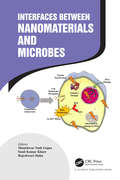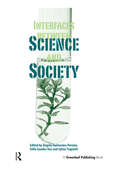- Table View
- List View
Interdisciplinary Language Arts and Science Instruction in Elementary Classrooms: Applying Research to Practice (Teaching And Learning In Science Ser.)
by Valarie L. AkersonThis volume brings together evidence-based approaches to interdisciplinary language arts and science instruction. Firmly grounded in the research showing cognitive parallels between the two subjects, and reflecting the many recommendations in recent years for using interdisciplinary instruction at the elementary level, its goal is to help teachers effectively use this kind of instruction in elementary classrooms. The book is organized around three themes:*Introduction to Interdisciplinary Science and Language Arts Instruction;*The Influence of Interdisciplinary Science and Language Arts Instruction on Children’s Learning; and*Research on Preparing Elementary Teachers to Use Interdisciplinary Science and Language Arts Instruction Each chapter summarizes the research on its focal topic. Examples of research applied to practice, and questions and prompts for discussion and reflection help readers apply what they are reading in their own classroom contexts. Teacher educators and prospective and practicing elementary teachers everywhere will benefit from this overview of current research and practice in interdisciplinary science and language arts instruction.
Interdisciplinary Mechatronics: Engineering Science and Research Development (Wiley-iste Ser.)
by J. Paulo Davim M. K. HabibMechatronics represents a unifying interdisciplinary and intelligent engineering science paradigm that features an interdisciplinary knowledge area and interactions in terms of the ways of work and thinking, practical experiences, and theoretical knowledge. Mechatronics successfully fuses (but is not limited to) mechanics, electrical, electronics, informatics and intelligent systems, intelligent control systems and advanced modeling, intelligent and autonomous robotic systems, optics, smart materials, actuators and biomedical and biomechanics, energy and sustainable development, systems engineering, artificial intelligence, intelligent computer control, computational intelligence, precision engineering and virtual modeling into a unified framework that enhances the design of products and manufacturing processes. Interdisciplinary Mechatronics concerns mastering a multitude of disciplines, technologies, and their interaction, whereas the science of mechatronics concerns the invention and development of new theories, models, concepts and tools in response to new needs evolving from interacting scientific disciplines. The book includes two sections, the first section includes chapters introducing research advances in mechatronics engineering, and the second section includes chapters that reflects the teaching approaches (theoretical, projects, and laboratories) and curriculum development for under- and postgraduate studies. Mechatronics engineering education focuses on producing engineers who can work in a high-technology environment, emphasize real-world hands-on experience, and engage in challenging problems and complex tasks with initiative, innovation and enthusiasm. Contents: 1. Interdisciplinary Mechatronics Engineering Science and the Evolution of Human Friendly and Adaptive Mechatronics, Maki K. Habib. 2. Micro-Nanomechatronics for Biological Cell Analysis and Assembly, Toshio Fukuda, Masahiro Nakajima, Masaru Takeuchi, Tao Yue and Hirotaka Tajima. 3. Biologically Inspired CPG-Based Locomotion Control System of a Biped Robot Using Nonlinear Oscillators with Phase Resetting, Shinya Aoi. 4. Modeling a Human’s Learning Processes toward Continuous Learning Support System, Tomohiro Yamaguchi, Kouki Takemori and Keiki Takadama. 5. PWM Waveform Generation Using Pulse-Type Hardware Neural Networks, Ken Saito, Minami Takato, Yoshifumi Sekine and Fumio Uchikoba. 6. Parallel Wrists: Limb Types, Singularities and New Perspectives, Raffaele Di Gregorio. 7. A Robot-Assisted Rehabilitation System – RehabRoby, Duygun Erol Barkana and Fatih Özkul. 8. MIMO Actuator Force Control of a Parallel Robot for Ankle Rehabilitation, Andrew Mcdaid, Yun Ho Tsoi and Shengquan Xie. 9. Performance Evaluation of a Probe Climber for Maintaining Wire Rope, Akihisa Tabata, Emiko Hara and Yoshio Aoki. 10. Fundamentals on the Use of Shape Memory Alloys in Soft Robotics, Matteo Cianchetti. 11. Tuned Modified Transpose Jacobian Control of Robotic Systems, S. A. A. Moosavian and M. Karimi. 12. Derivative-Free Nonlinear Kalman Filtering for PMSG Sensorless Control, Gerasimos Rigatos, Pierluigi Siano and Nikolaos Zervos. 13. Construction and Control of Parallel Robots, Moharam Habibnejad Korayem, Soleiman Manteghi and Hami Tourajizadeh. 14. A Localization System for Mobile Robot Using Scanning Laser and Ultrasonic Measurement, Kai Liu, Hongbo Li and Zengqi Sun. 15. Building of Open-Structure Wheel-Based Mobile Robotic Platform, Aleksandar Rodic and Ivan Stojkovic. 16. Design and Physical Implementation of Holonomous Mobile Robot–Holbos, Jasmin Velagic, Admir Kaknjo, Faruk Dautovic, Muhidin Hujdur and Nedim Osmic. 17. Advanced Artificial Vision and Mobile Devices for New Applications in Learning, Entertainment and Cultural Heritage Do
Interdisciplinary Pedagogy for STEM
by Reneta D. LansiquotThis book focuses on constructivist theory and collaborative interdisciplinary studies, showing how constructivist theory complements interdisciplinary studies. Constructivist theory stresses how learners construct new ideas and concepts, while the interdisciplinary method requires that learners approach complex problems from multiple perspectives. The author uses the New York City College of Technology as a model to demonstrate how learning can be embedded in complex, realistic, and relevant environments. As a result, students learn to consider significant issues from a variety of viewpoints and thus negotiate their social landscape. In approaching problems that they recognize as meaningful, they take ownership of their learning and become increasingly self-aware. This scholarly book makes a theoretical contribution to its field while also offering a practical, real world example of how to successfully integrate a curriculum.
Interdisciplinary Perspectives on Sustainable Development: Achieving the SDGs through Education, Wellbeing, and Innovation
by Sai Kiran Oruganti Sudeshna Ray Dimitrios A. KarrasISC 2022 is dedicated to the Niti Aayog policies to promote sustainability through exchange of ideas emerging out of the academia. The ISC is an annual conference that is held in virtual mode until COVID restrictions on travel exist. The vision of the conference is to capacitate Academia with the necessary ideas that provide insights of the grassroot level development to various stakeholders of the Niti-Aayog policies. Towards this goal, the conference creates a conjunction of various stakeholders of Niti-Aayog policies that include- academic institutions, government bodies, policy makers and industry. The ISC organizers make concerted efforts to promote academic research that would technological, scientific, management & business practices, and insights into policy merits & disruptions. The framework of exchange of ideas is geared towards adoption of deep technologies, fundamental sciences & engineering, energy research, energy policies, advances in medicine & related case studies. This framework enables the round table discussions between the academia, industry and policy makers through its range of plenary and keynote speakers.
Interdisciplinary Perspectives on Virtual Place-Based Learning
by Reneta D. Lansiquot Sean P. MacDonaldThis book explores how virtual place-based learning and research has been interpreted and incorporated into learning environments both within and across disciplinary perspectives. Contributing authors highlight the ways in which they have employed a variety of methodologies to engage students in the virtual exploration of place. In the process, they focus on the approaches they have used to bring the real world closer through virtual exploration. Chapters examine how the resources of the urban environment have been tapped to design student research projects within the context of an interdisciplinary course. In this way, authors highlight how virtual place-based learning has employed the tools of mapping and data visualization, information literacy, game design, digital storytelling, and the creation of non-fiction VR documentaries. This book makes a valuable contribution to the literature, offering a model of how the study of place can be employed in creative ways to enhance interdisciplinary learning.
Interdisciplinary Research for Printing and Packaging (Lecture Notes in Electrical Engineering #896)
by Min Xu Li Yang Pengfei Zhao Zhuangzhi Ye Shu Yan Linghao ZhangThis book includes original, peer-reviewed research papers from the 12th China Academic Conference on Printing and Packaging (CACPP 2021), held in Beijing, China on November 12-14, 2021. The proceedings cover the recent findings in color science and technology, image processing technology, digital media technology, mechanical and electronic engineering and numerical control, materials and detection, digital process management technology in printing and packaging, and other technologies. As such, the book is of interest to university researchers, R&D engineers and graduate students in the field of graphic arts, packaging, color science, image science, material science, computer science, digital media, network technology, and smart manufacturing technology.
Interdisciplinary Research in Technology and Management: Proceedings of the International Conference on Interdisciplinary Research in Technology and Management (IRTM, 2021), 26-28 February,2021, Kolkata, India
by Satyajit Chakrabarti; Rintu Nath; Pradipta Kumar Banerji; Sujit Datta; Sanghamitra Poddar; Malay GangopadhyayaThe conference on ‘Interdisciplinary Research in Technology and Management” was a bold experiment in deviating from thetraditional approach of conferences which focus on a specific topic or theme. By attempting to bring diverse inter-relatedtopics on a common platform, the conference has sought to answer a long felt need and give a fillip to interdisciplinaryresearch not only within the technology domain but across domains in the management field as well.The spectrum of topics covered in the research papers is too wide to be singled out for specific mention but it isnoteworthy that these papers addressed many important and relevant concerns of the day.
Interdisciplinary Research in Technology and Management: Proceedings of the International Conference on Interdisciplinary Research in Technology and Management (IRTM, 2022), 24-26th February 2022, Kolkata, India
by Satyajit Chakrabarti Rohit Singh Pradipta Kumar Banerji Sanghamitra Poddar Malay Gangopadhyaya Ashiq A. Sakib Anupam Bhattacharya Srijita ChakrabortyWe live in an inter-connected world. In the era of Industry 4.0, technology is getting embedded more and more in the way ‘we learn, live, work, and play’. This progression is accelerating at a pace never seen before. Interdisciplinary and collaborative research across disciplines within the Technology domain and Management domain, and across the Technology-Management interface is opening up exciting new possibilities for solving problems whose solutions are beyond the scope of a single discipline, domain or practice, and helping to create a brave new world. The goal of this conference was to bring together scholars, researchers, consultants, and practitioners to share their interdisciplinary research and consultative work in Technology and Management. Selected papers were then peer-reviewed and authors were invited to present their work in the conference.
Interdisciplinary Technological Advancements in Smart Cities (EAI/Springer Innovations in Communication and Computing)
by Cristina Costa Arij Naser Abougreen Shilpa MehtaThis book explores interdisciplinary technological advancements in smart cities. The book begins with a comprehensive study of smart cities, followed by their benefits and shortcomings. The authors show how, with the help of digital technology, cities are becoming more sustainable and efficient, leading to a better quality of life. The book includes a comprehensive review of literature, research works, and case studies, which are presented to demonstrate how various technologies can be integrated into smart cities. The book includes scenarios in smart agriculture, smart transportation, smart healthcare and more. This book also offers researchers, students, academicians, and professionals working in this field an extensive range of smart city applications.
Interdisciplinary Treatment to Arc Welding Power Sources
by S. Arungalai Vendan Liang Gao Akhil Garg P. Kavitha G. Dhivyasri Rahul SgThis book presents the fundamentals of arc phenomena, various arc welding power sources, their control strategies, welding data acquisition, and welding optimization. In addition, it discusses a broad range of electrical concepts in welding, including power source characteristics, associated parameters, arc welding power source classification, control strategies, data acquisitions techniques, as well as optimization methods. It also offers advice on how to minimize the flaws and improve the efficacy and performance of welds, as well as insights into the mechanical behavior expressed in terms of electromagnetic phenomena, which is rarely addressed. The book provides a comprehensive review of interdisciplinary concepts, offering researchers a wide selection of strategies, parameters, and sequences of operations to choose from.
Interdisciplinary and Social Nature of Engineering Practices: Philosophy, Examples and Approaches (Studies in Applied Philosophy, Epistemology and Rational Ethics #61)
by Paulo Fernando Ribeiro Antonio Carlos Zambroni de Souza Maarten J. VerkerkThis book covers practical and philosophical aspects of Engineering, paying special attention to the social impacts of emerging technologies. Some fundamentals of philosophy of technology are introduced followed by social, economic, and environmental discussion and implications in different disciplines. Each chapter provides insights on the responsibilities involved in the design of engineering projects. The examples presented combine concepts about the impacts of Engineering in society at the same time that incorporates new technological models, yielding an innovative approach about the topics.
Interdisciplining Digital Humanities: Boundary Work In An Emerging Field
by Julie Thompson KleinInterdisciplining Digital Humanities sorts through definitions and patterns of practice over roughly sixty-five years of work, providing an overview for specialists and a general audience alike. It is the only book that tests the widespread claim that Digital Humanities is interdisciplinary. By examining the boundary work of constructing, expanding, and sustaining a new field, it depicts both the ways this new field is being situated within individual domains and dynamic cross-fertilizations that are fostering new relationships across academic boundaries. It also accounts for digital reinvigorations of "public humanities" in cultural heritage institutions of museums, archives, libraries, and community forums.
Interface
by Branden HookwayIn this book, Branden Hookway considers the interface not as technology but as a form of relationship with technology. The interface, Hookway proposes, is at once ubiquitous and hidden from view. It is both the bottleneck through which our relationship to technology must pass and a productive encounter embedded within the use of technology. It is a site of contestation -- between human and machine, between the material and the social, between the political and the technological -- that both defines and elides differences. A virtuoso in multiple disciplines, Hookway offers a theory of the interface that draws on cultural theory, political theory, philosophy, art, architecture, new media, and the history of science and technology. He argues that the theoretical mechanism of the interface offers a powerful approach to questions of the human relationship to technology. Hookway finds the origin of the term interface in nineteenth-century fluid dynamics and traces its migration to thermodynamics, information theory, and cybernetics. He discusses issues of subject formation, agency, power, and control, within contexts that include technology, politics, and the social role of games. He considers the technological augmentation of humans and the human-machine system, discussing notions of embodied intelligence. Hookway views the figure of the subject as both receiver and active producer in processes of subjectification. The interface, he argues, stands in a relation both alien and intimate, vertiginous and orienting to those who cross its threshold.
Interface (The\mit Press Ser.)
by Branden HookwayA cultural theory of the interface as a relation that is both ubiquitous and elusive, drawing on disciplines from cultural theory to architecture.In this book, Branden Hookway considers the interface not as technology but as a form of relationship with technology. The interface, Hookway proposes, is at once ubiquitous and hidden from view. It is both the bottleneck through which our relationship to technology must pass and a productive encounter embedded within the use of technology. It is a site of contestation—between human and machine, between the material and the social, between the political and the technological—that both defines and elides differences.A virtuoso in multiple disciplines, Hookway offers a theory of the interface that draws on cultural theory, political theory, philosophy, art, architecture, new media, and the history of science and technology. He argues that the theoretical mechanism of the interface offers a powerful approach to questions of the human relationship to technology. Hookway finds the origin of the term interface in nineteenth-century fluid dynamics and traces its migration to thermodynamics, information theory, and cybernetics. He discusses issues of subject formation, agency, power, and control, within contexts that include technology, politics, and the social role of games. He considers the technological augmentation of humans and the human-machine system, discussing notions of embodied intelligence.Hookway views the figure of the subject as both receiver and active producer in processes of subjectification. The interface, he argues, stands in a relation both alien and intimate, vertiginous and orienting to those who cross its threshold.
Interface / Interphase in Polymer Nanocomposites
by K. L. Mittal Anil N. NetravaliSignificant research has been done in polymeric nanocomposites and progress has been made in understanding nanofiller-polymer interface and interphase and their relation to nanocomposite properties. However, the information is scattered in many different publication media. This is the first book that consolidates the current knowledge on understanding, characterization and tailoring interfacial interactions between nanofillers and polymers by bringing together leading researchers and experts in this field to present their cutting edge research. Eleven chapters authored by senior subject specialists cover topics including: Thermodynamic mechanisms governing nanofiller dispersion, engineering of interphase with nanofillers Role of interphase in governing the mechanical, electrical, thermal and other functional properties of nanocomposites, characterization and modelling of the interphase Effects of crystallization on the interface, chemical and physical techniques for surface modification of nanocellulose reinforcements Electro-micromechanical and nanoindentation techniques for interface evaluation, molecular dynamics (MD) simulations to quantify filler-matrix adhesion and nanocomposite mechanical properties.
Interface Development for Learning Environments: Establishing Connections Between Users and Learning (SpringerBriefs in Educational Communications and Technology)
by Joseph Frantiska Jr.This brief will examine and explore some tools and techniques that can be used to develop interfaces for learning environments. Interface design has been a topic in software engineering for many years. The advent of graphical user interfaces has created many remedies and challenges for the software engineer. In recent years with an increased emphasis in educational technology, instructional designers are also included in this arena. The interface can be a driver in terms of a learning environment’s ability to engage a student. It can also provide a point of information exchange and therefore learning between the student and the environment’s software. Thus, the issue of an interface is vital to the success of a learning environment. This brief will produce a variety of interfaces for various environments to allow the designer to contrast and compare them based upon the required purpose. The designer will have a toolkit filled with tools and techniques which will allow for interfaces that will engage the student and facilitate their learning. The primary audiences are K-12 and post-secondary educators who desire to create digital media based educational materials.
Interface Engineering in Organic Field-Effect Transistors
by Xuefeng Guo Hongliang ChenInterface Engineering in Organic Field-Effect Transistors Systematic summary of advances in developing effective methodologies of interface engineering in organic field-effect transistors, from models to experimental techniques Interface Engineering in Organic Field-Effect Transistors covers the state of the art in organic field-effect transistors and reviews charge transport at the interfaces, device design concepts, and device fabrication processes, and gives an outlook on the development of future optoelectronic devices. This book starts with an overview of the commonly adopted methods to obtain various semiconductor/semiconductor interfaces and charge transport mechanisms at these heterogeneous interfaces. Then, it covers the modification at the semiconductor/electrode interfaces, through which to tune the work function of electrodes as well as reveal charge injection mechanisms at the interfaces. Charge transport physics at the semiconductor/dielectric interface is discussed in detail. The book describes the remarkable effect of SAM modification on the semiconductor film morphology and thus the electrical performance. In particular, valuable analyses of charge trapping/detrapping engineering at the interface to realize new functions are summarized. Finally, the sensing mechanisms that occur at the semiconductor/environment interfaces of OFETs and the unique detection methods capable of interfacing organic electronics with biology are discussed. Specific sample topics covered in Interface Engineering in Organic Field-Effect Transistors include: Noncovalent modification methods, charge insertion layer at the electrode surface, dielectric surface passivation methods, and covalent modification methods Charge transport mechanism in bulk semiconductors, influence of additives on materials’ nucleation and morphology, solvent additives, and nucleation agents Nanoconfinement effect, enhancing the performance through semiconductor heterojunctions, planar bilayer heterostructure, ambipolar charge-transfer complex, and supramolecular arrangement of heterojunctions Dielectric effect in OFETs, dielectric modification to tune semiconductor morphology, surface energy control, microstructure design, solution shearing, eliminating interfacial traps, and SAM/SiO2 dielectrics A timely resource providing the latest developments in the field and emphasizing new insights for building reliable organic electronic devices, Interface Engineering in Organic Field-Effect Transistors is essential for researchers, scientists, and other interface-related professionals in the fields of organic electronics, nanoelectronics, surface science, solar cells, and sensors.
Interface Fantasy: A Lacanian Cyborg Ontology (Short Circuits)
by Andre NusselderBehind our computer screens we are all cyborgs: through fantasy we can understand our involvement in virtual worlds.Cyberspace is first and foremost a mental space. Therefore we need to take a psychological approach to understand our experiences in it. In Interface Fantasy, André Nusselder uses the core psychoanalytic notion of fantasy to examine our relationship to computers and digital technology. Lacanian psychoanalysis considers fantasy to be an indispensable “screen” for our interaction with the outside world; Nusselder argues that, at the mental level, computer screens and other human-computer interfaces incorporate this function of fantasy: they mediate the real and the virtual. Interface Fantasy illuminates our attachment to new media: why we love our devices; why we are fascinated by the images on their screens; and how it is possible that virtual images can provide physical pleasure. Nusselder puts such phenomena as avatars, role playing, cybersex, computer psychotherapy, and Internet addiction in the context of established psychoanalytic theory. The virtual identities we assume in virtual worlds, exemplified best by avatars consisting of both realistic and symbolic self-representations, illustrate the three orders that Lacan uses to analyze human reality: the imaginary, the symbolic, and the real. Nusselder analyzes our most intimate involvement with information technology—the almost invisible, affective aspects of technology that have the greatest impact on our lives. Interface Fantasy lays the foundation for a new way of thinking that acknowledges the pivotal role of the screen in the current world of information. And it gives an intelligible overview of basic Lacanian principles (including fantasy, language, the virtual, the real, embodiment, and enjoyment) that shows their enormous relevance for understanding the current state of media technology.
Interface Influence on Moisture Transport in Building Components: The Wetting Process (SpringerBriefs in Applied Sciences and Technology)
by Ana S. Guimarães António C. Azevedo João M. DelgadoThe knowledge of moisture migration inside building materials and construction building components is decisive for the way they behave when in use. The durability, waterproofing, degrading aspect and thermal behaviour of these materials are strongly influenced by the existence of moisture within their interior, which provoke changes in their normal performance, something that is normally hard to predict. Due to the awareness of this problem, the scientific community have per-formed various studies about the existence of moisture inside porous materials. The complex aspects of moisture migration phenomenon tended to encompass monolithic building elements, since the existence of joints or layers contributes to the change of moisture transfer along the respective building element that contribute to the change of mass transfer law. The presentation of an experimental analyses concerning moisture transfer in the interface of material that makes up masonry is described in such a way as to evaluate the durability and/or avoid building damages. In this work it was analysed, during the wetting process, the influence of different types of interface, commonly observed in masonry, such as: perfect con-tact, joints of cement mortar, lime mortar, and the air space interface. The results allow the calculation of the hygric resistance. With these results, it is possible to use any advanced hygrothermal simulation program to study the water transport in building elements, considering different interfaces and their hygric resistance.
Interface Ionics: For All-Solid-State Batteries and Solid State Ionics Devices (The Materials Research Society Series)
by Yasutoshi Iriyama Koji Amezawa Yoshitaka Tateyama Naoaki YabuuchiThis book focuses on ion transport and storage around the interfaces in solid-state-ionics devices, especially for all-solid-state batteries. It covers materials research from fundamental model systems to practically important materials, advanced analysis methods, and computational & data science. This volume is intended for researchers in academia and industry who have studied or worked in this field. It is expected to provide readers with guidelines for interface and material design aimed at advancing all-solid-state batteries, as well as insights into the development of novel solid-state ionics devices. This book is a summary of the studies obtained in the Grant-in-Aid for Scientific Research on Innovative Areas "Interface Ionics” founded by the Japanese Ministry of Education, Culture, Sports, Science and Technology (MEXT) during 2019-2023.
Interface Oral Health Science 2009
by Martin A. Taubman Toshihisa Kawai Osamu Suzuki Henry C. Margolis Nobuhiro Takahashi Keiichi Sasaki Takashi Sasano Philip StashenkoThe Tohoku University Graduate School of Dentistry has proposed Interface Oral Health Science as the main theme of next-generation dental research since 2002. That theme is based on the new concept that healthy oral function is provided by biological and biomechanical harmony among three systems: oral tissues, parasites, and biomaterials, and that oral diseases are interpreted as "interface diseases" caused by disruption of the intact interfaces among those systems.
Interface Oral Health Science 2011
by Keiichi SasakiInterface oral health science was founded on the concept that healthy oral function is maintained by biological and biomechanical harmony between three systems: oral tissues, parasitic oral microorganisms, and biomaterials. On that basis, dental caries, periodontal disease, and temporomandibular joint disorders may be regarded as interface disorders that result from a disruption in the intact interface of these systems. Interface oral health science encompasses the fields of dentistry and dental medicine, but also extends to general medicine, agriculture, biomaterials science, bioengineering, and pharmacology. This book is a compendium of the research presented at symposiums held in 2011 by the Tohoku University Graduate School of Dentistry and by the Forsyth Institute. Its publication is intended provide further impetus for the progress of oral science and health, pointing the way for dental research for future generations.
Interface of Ceramic-Matrix Composites: Design, Characterization, and Damage Effects
by Longbiao LiThe book "Interfaces of Ceramic-Matrix Composites" demonstrates the definition, function and type of the interface of ceramic-matrix composites and gives comprehensive investigations on the interface design, interface characterization, interface assessment, and interface damage law of both C/SiC and SiC/SiC ceramic-matrix composites subjected to tensile and fatigue loading at different testing conditions. Thereby, it helps material designers and engineers to better design ceramic-matrix composite components for applications.
Interfaces Between Nanomaterials and Microbes
by Munishwar Nath Gupta; Sunil Kumar Khare; Rajeshwari SinhaNanomaterials are becoming ubiquitous; microbes similarly are everywhere. This book focuses on various ways the diverse nanomaterials interact with microbial communities and implications of such interactions. Both toxicity and beneficial effects of nanomaterial-microbe interactions have been covered. This includes areas such as fate and bioavailability of nanomaterials in environments, microbial synthesis of nanomaterials and antimicrobial action of nanomaterials. Fairly comprehensive but with narrow focus, the book provides useful insights into these interactions which need to be factored in while designing nanoscience based new technologies.
Interfaces between Science and Society
by Ângela Guimarães Pereira Sofia Guedes Vaz Sylvia TognettiThe project of science has been to provide answers to questions about the world and how it works. Often, this lofty role has been characterised by a narrow and dogmatic scientific training, an unwillingness to communicate to differing stakeholder needs, a refusal to accept and to manage uncertainty, complexity and value commitments, and the reduction of knowledge assessment to colleague peer review on narrowly technical issues. Times have changed. As the world faces increasingly disparate challenges, science is subjected to increasingly vehement demands from a society calling for transparency, openness and public participation in science policy. Science is going through an evolutionary process. Perhaps the most painful process it has ever encountered. Research on the interfaces between science and society is a burgeoning area. A new conception of knowledge now appears to be emerging, based on the awareness of complexity, uncertainty and a plurality of legitimate perspectives and interests. Democracy is extending into the previously quite exclusive scientific realm, and science must now submit to public scrutiny and participation in the governance of knowledge. This book provides much-needed reflections on the methods and tools for knowledge quality assurance, particularly on its inputs to extended policy and decision-making processes. The overall aim is to improve the relationship between science and society. The discussion involves six themes: communicating between plural perspectives; accepting and learning how to manage uncertainty, complexity and value commitments; acknowledging new conceptions of knowledge; implementing transparency, openness and participation in science policy; valuing community-based research; and exploring how new ICT can support inclusive governance. Taken together, these themes provide both a framework and vision on how to conceive, discuss and evaluate the changes that are occurring. The chapters cover theory, practice, approaches, experiences, ideas and suggestions for a move beyond "talking the talk" to "walking the walk". Science and policy interfaces are dynamic processes needing to permanently redefine themselves and their roles. This book contributes to the enrichment and deepening of our understanding of these important new trends in the social relations of science, which are fundamental to our understanding of the prospects for further progress. The book will be essential reading for scientists, policy-makers, managers and the public.
